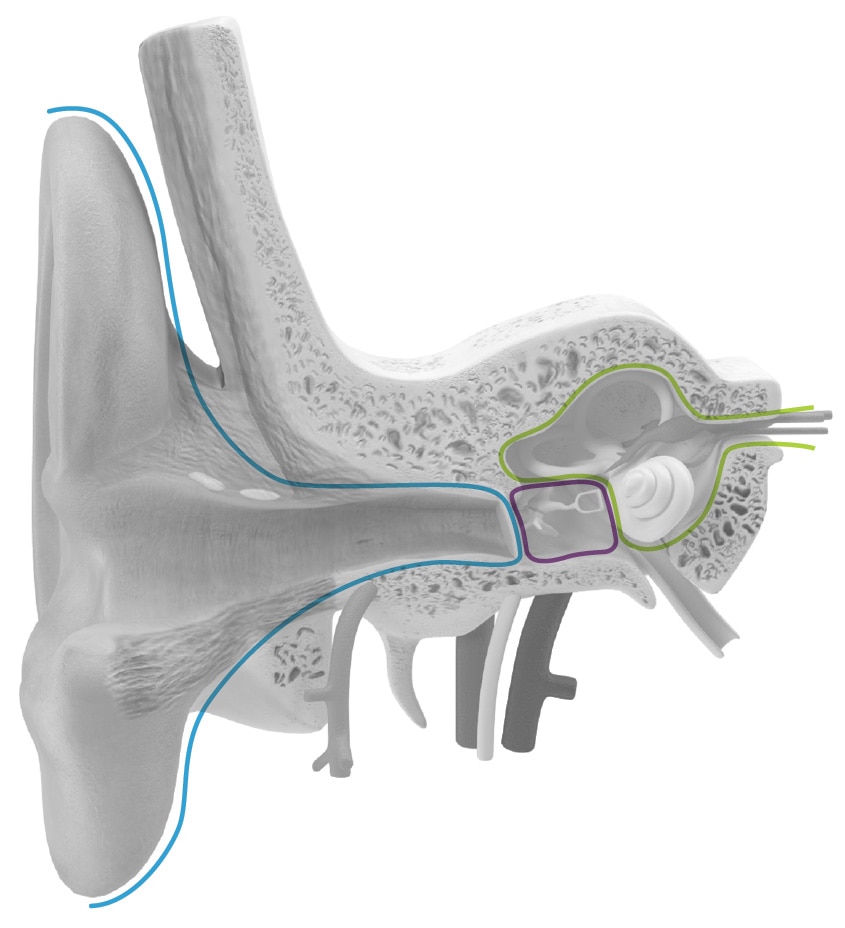What kind of hearing loss do I have?
Finding out that you have hearing loss can create a firestorm of questions in your mind. How did this happen? Will it get worse? Will I lose my hearing completely? Can hearing aids help me? What if hearing aids can't help me? These are all excellent questions, but one of the first questions your audiologist will answer for you is, “What kind of hearing loss do I have?”
There are three different categories of hearing loss: sensorineural, conductive, and mixed. To understand the difference between the three, it helps to first understand the anatomy of the ear and how we hear, and how these categories relate to different types of hearing problems.
How we hear
The ear is divided into three parts: the outer, middle, and inner ear. The outer ear consists of the visible part of the ear on either side of our heads, called the pinna, and the ear canal. Inside the middle ear (an air-filled space behind the eardrum) are three of the tiniest bones in your body, collectively called the ossicles. On the other side of the middle ear is the inner ear. The inner ear includes the sensory organ responsible for hearing—called the cochlea—as well as the sensory organs for balance.

OUTER EAR acts as a funnel to collect sound vibrations and conducts them to the eardrum.
MIDDLE EAR amplifies the sound vibrations and conducts them to the inner ear.
INNER EAR contains the cochlea which converts sound vibrations into neural impulses that travel up the auditory nerve.
The pinna picks up the sound waves in the environment, which then travel down the ear canal and cause the eardrum to vibrate. The ossicles, which are attached to the eardrum, vibrate in response, and send the signal to the cochlea. In the cochlea, tiny hair-like cells pick up these vibrations and send neural impulses along the auditory nerve, from the cochlea up to the brain. The brain is then able to interpret these neural impulses as sound.
We categorize hearing loss based on where the damage is located in the ear, and the location at which sound cannot be properly conducted to the brain.
Types of Hearing Loss:
Sensorineural Hearing Loss
This is the most common type of hearing loss. It’s caused by damage to the cochlea or to the hearing nerve or both.
Sensorineural hearing loss is typically permanent. A baby born with sensorineural hearing loss might have inherited it or might have developed it while the mother was pregnant, particularly had she contracted certain diseases such as toxoplasmosis, rubella, or herpes. Sensorineural hearing loss in children and adults can have a variety of causes:
- Exposure to very loud noises
- Certain diseases, including auto-immune diseases
- Some types of medications
- Traumatic injuries to the head and ears
- Deterioration of inner ear structures caused by age
Many people who experience this type of hearing loss say that sounds are not clear and are not loud enough. Oftentimes they can hear that someone is speaking, but the speech is not clear. Other symptoms include:
- Problems hearing in noisy environments
- Difficulty hearing children’s voices
- Trouble distinguishing an “s” from a “th” sound
Although there are typically no medical or surgical treatments for sensorineural hearing loss, hearing aids or cochlear implants can often help.
Conductive Hearing Loss
Conductive hearing loss is caused by problems in the outer and/or middle ear, and the loss can be temporary or permanent. Some of the things that can cause it are:
- Fluid in the middle ear
- Build-up of earwax
- A hole in the eardrum
- Deformities of the outer or middle ear
- Traumatic injuries which damage the outer or middle ear
- Certain diseases
Symptoms of conductive hearing loss can include:
- Discomfort, pressure, or pain in the ear
- A sense that a person’s own voice is very loud
Depending on the cause of conductive hearing loss, there are sometimes medical or surgical treatments available. Conductive hearing loss caused by wax impaction, foreign objects, abnormal growths, or ear infections can often be corrected. When conductive hearing loss is permanent, traditional or bone-conduction hearing aids, bone-anchored implantable devices, or middle ear implants can be helpful.
Mixed Hearing Loss
This kind of hearing loss occurs when there is a combination of sensorineural loss and a conductive hearing loss. This could be caused, for example, when someone has had inner ear damage due to excessive noise exposure and who may also have a middle ear infection. Another example would be a blast injury which both damaged the outer or middle ear structures, and was loud enough to cause damage in the inner ear as well.
With all three of these hearing losses, there are usually treatment options that can be considered. If you suspect that you or a loved one may have any kind of hearing loss, the first step is to speak to a hearing care professional who can carry out an assessment.
